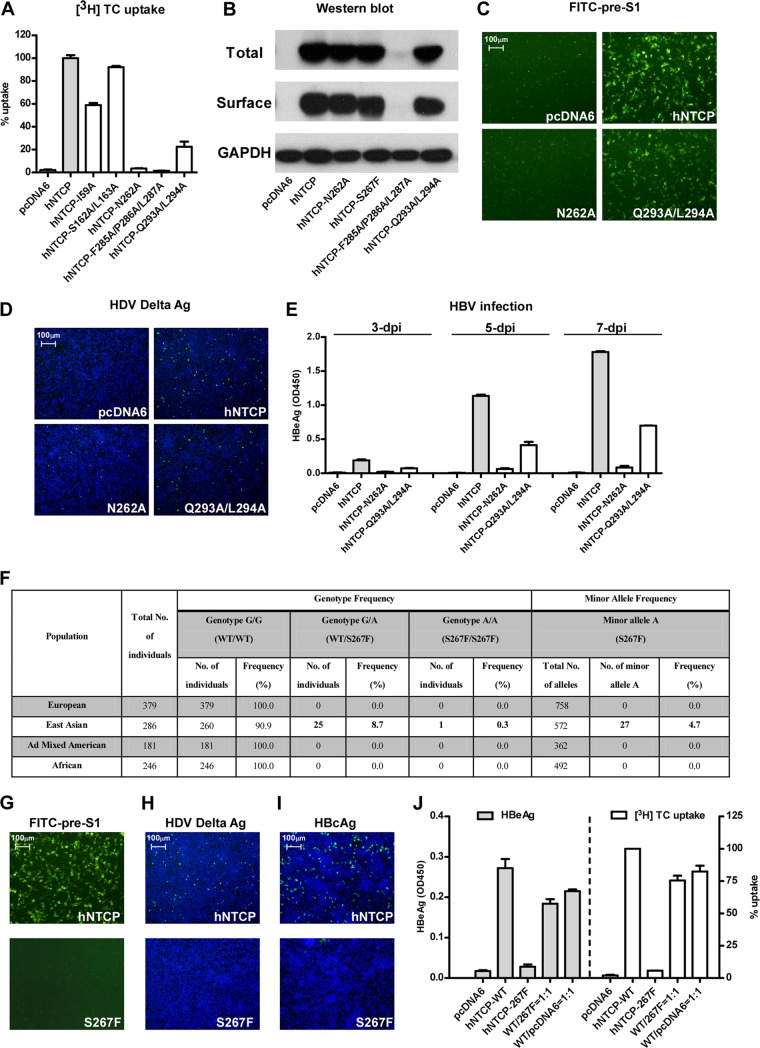FIG 5.
NTCP mutants, corresponding to the residues important for bile salts binding/uptake, inhibited viral infections by HDV and HBV. (A) [3H]taurocholate uptake efficiency of HepG2 cells complemented with various NTCP mutants. HepG2 cells were transfected with NTCP mutants, followed by further culturing in PMM for 24 h before examination of their [3H]taurocholate uptake efficiency. (B) Total and surface expression levels of NTCP mutants in HepG2 cells. HepG2 cells were transfected with the indicated NTCP variants and then cultured in PMM for 24 h. Cells were then lysed by RIPA buffer, and the total and surface expression levels were analyzed by Western blotting. The expression level of GAPDH was used as an internal control. (C) FITC–pre-S1 binding efficiency of NTCP variants. HepG2 cells transfected as described for panel A were incubated with 400 nM FITC–pre-S1 at 37°C for 2 h, and the images were captured with a fluorescence microscope. (D) HDV infection efficiency for HepG2 cells transfected with NTCP variants. The intracellular delta antigen was stained with MAb 4G5 at 8 days p.i. (E) HBV infection of HepG2 cells expressing NTCP variants. The levels of HBeAg in the culture medium from HBV-infected HepG2 cells expressing the indicated NTCP variants were measured at 3, 5, and 7 days p.i. (F) Genotype frequency and allele frequency of the SNP that causes the NTCP S267F variant in different populations; the variant is caused by a single-nucleotide G-to-A change (rs2296651). The SNP is located at chromosome 14:70245193 (Ensembl Homo sapiens version 73.37) and corresponds to a C-to-T change in codon 267 (from TCC to TTC) on the reverse strand encoding human NTCP. According to data from the 1000 Genomes Project (http://www.1000genomes.org), in East Asia the heterozygous genotype frequency is 8.7%, and the minor allele homozygous genotype frequency is 0.3%. No SNP at this position is observed in other populations. The genotype distribution in East Asian population conforms to a Hardy-Weinberg equilibrium, which was verified by a chi-square test (P = 0.22). WT, wild type; Ad mixed, populations with recent ancestry from two or more genetically separated populations. (G) FITC–pre-S1 binding efficiency of NTCP in cells complemented with wild-type NTCP or a NTCP-S267F variant. (H and I) HDV and HBV infection efficiencies on HepG2 cells transfected with NTCP or NTCP-S267F. The intracellular delta antigen in the infected cells was stained with MAb 4G5 at 8 days p.i. (H). HBcAg was evaluated based on intracellular HBcAg at 8 days p.i. (I). (J) HBV infection efficiency and [3H]taurocholate uptake efficiency of HepG2 cells transfected with plasmid carrying wild-type (WT) NTCP, NTCP variant S267F, pcDNA6, or a mixture of the wild-type NTCP with either the S267F variant or pcDNA6 plasmid at a ratio of 1:1. The total amount of DNA for all the transfections was 1 μg DNA for ∼1.7 × 105 HepG2 cells. The level of secreted HBeAg at 6 days p.i. was measured in an ELISA (left), and the [3H]taurocholate uptake efficiency at 24 h posttransfection was determined by liquid scintillation (wild-type NTCP was set to 100%) (right).

